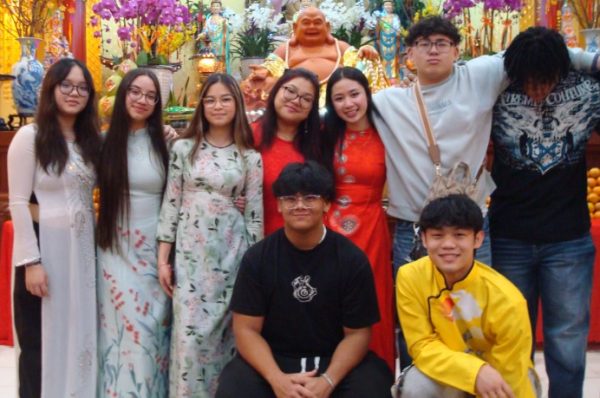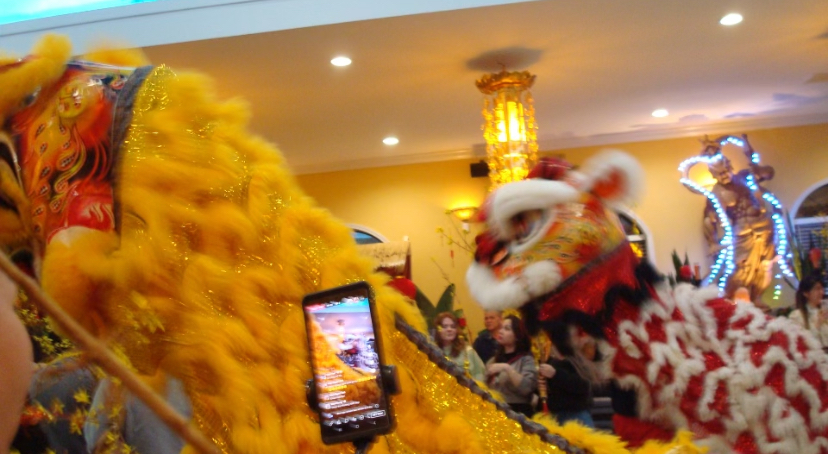Celebrated by over 1.5 billion each year, the Lunar New Year is a holiday, rich in tradition and meaning, both of which can vary from culture to culture.
The holiday is based on the lunisolar calendar which indicates both the moon phase and the time of the solar year, so the celebrations take place on a different date each year. In 2024, the celebrations took place on Feb. 10. For Dylan Do (12), he practices Vietnamese traditions.
“We start off [the celebrations] by praying and then it’s 20 to 30 minutes of us just sitting down,” Do said. “The monks were reading and stuff like that and then we all got up and they gave out stuff like branches, little red envelopes and charms and a bracelet. After that, everybody went outside to watch the fireworks.”
Lunar New Year can take months of preparation. From the clothes specially made for the holiday to the multitudes of dances and performances, many families take their time to make sure that the Lunar New Year can be celebrated properly.
“All I do [to prepare for the celebrations] is I wear a Vietnamese dress that I have custom made months before, and then me and my mom would just get ready and get our lanterns then go to the gym,” Jenny Nguyen (11) said. “Usually we light [the lanterns] up and then all the kids go walk around the temple with it and there will just be music and dancing … It’s just a sense of what your culture is. So for Vietnamese [culture], we just eat our typical jellos.”
Traditional celebrations include dragon and lion dances as well as musical and instrumental performances. Aside from the common practices that bind everyone who celebrates the Lunar New Year, some countries and families have their own traditions that make the holiday even more special.

“[To celebrate] we did a little family gambling,” Do said. “It was kind of like bingo where they call out numbers and you have to get five in a row and if you do, you win the money that we all put in … There are two cards with the same color and if you get two of them you have to pay two dollars … So whoever won that one gets all the money and then they can use it to buy more cards.”
The festivities held each year are often referred to as the ‘Chinese New Year.’ Originating in China, the holiday is now celebrated by multiple Asian cultures across the globe. As celebrations spread, so did the use of the ‘Lunar New Year’ as the holiday’s identifier.
“Lunar New Year is an umbrella term for all the different cultural celebrations, but generally there really is no big difference between the two They’re used synonymously, even my mom says Lunar New Year,” Andrew Chan (11) said.
Before the Lunar New Year, families often clean their homes to rid their space of any bad luck. However, in the days following the celebrations, cleaning is seen as ‘sweeping away’ the good luck that was welcomed into their home.
“My family usually just celebrates the first few days of it even though the holiday itself lasts 16 days,” Chan said. “We decorate our home with lots of red decorations like lanterns, banners with lucky sayings and paper cutouts. My family cleans the house thoroughly because cleaning symbolizes sweeping away bad luck from the old year and making a fresh start. My parents prepare the red envelopes and we all pitch in to make our favorite dishes. We always get new clothes in general – a fresh start for the New Year and all that.”
In America, the festivities of the Lunar New Year are on a lesser scale than those of the holiday’s home countries. In China, celebrations can last the full 16-day celebration period and can fill the streets with constant music and dance.
“I feel like my family’s celebrations are pretty typical compared to everyone else I know, not too old-fashioned or traditional like it might be back in China, but definitely festive,” Chan said. “Celebrations in China are massive, with huge city-wide parades, elaborate fireworks and everyone seeming to be on the move to visit family. Here you can definitely feel it but it’s obviously not as big. There are a lot of minute differences but food is definitely something that isn’t the same for every country.”
Family usually plays a large role in the celebrations of the Lunar New Year. Many families gather with as many relatives as they can to celebrate their culture. Some families come together to make cultural dishes for meals that are typically held on New Year’s Eve.
“Instead of on actual New Year’s, like January 1, we just make dumplings and stuff [for the Lunar New Year],” Junwon Choi (10) said. “All the Chinese families, they give out the little red envelopes and stuff, but my family doesn’t really do that because we don’t have any extended family that [are] like [in Memphis].”
Although the traditions of the Lunar New Year are different from family to family, appreciation of the holiday becomes a broader connection. During the festivities many find themselves learning more about the culture behind the holiday.
“[During celebrations] people like to show their culture and stuff because I’m Korean and I don’t really know that much of the Chinese stuff that they were doing on this stage — it was kind of a good learning experience for me,” Choi said.





































